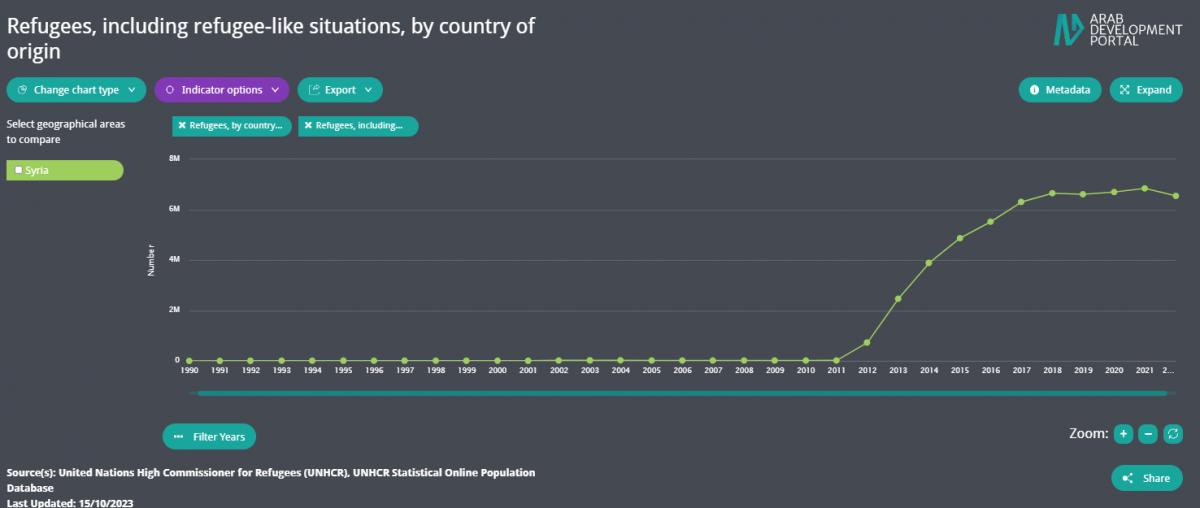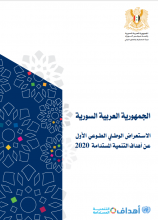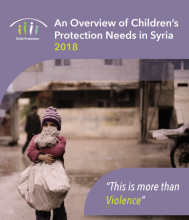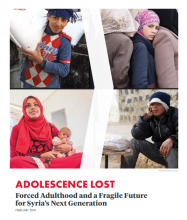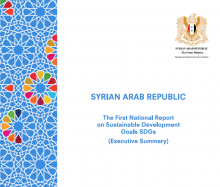 Syria
Syria
Syria’s estimated population reached 21.5 million in 2022, down from 22.5 million in 2011, when conflict erupted.[1] The war has led to one of the largest refugee crises in the world, with Syrian refugees making up almost a quarter of all refugees globally. More than 12 million people have been formally displaced – half of Syria’s 2011 population—including more than 6.7 million internally displaced people and 6.5 million refugees as per the latest UNHCR data in 2022.[2] Most Syrian refugees continue to live in the region, mostly in urban host community areas with 63.2 percent residing in Turkey, 15.2 percent in Lebanon, 12.6 percent in Jordan, 5.2 percent in Iraq, and 3.8 percent in North Africa.[2] A quarter of all registered Syrian refugees in the Arab region are children below the age of 18.[2]
Conflict in Syria has taken a very heavy toll on the economy, eroding livelihoods, destroying infrastructure, and disrupting service provision since 2011. According to the World Bank estimates, Syria’s GDP shrank by more than half between 2010 and 2020.[5] Accumulated losses till 2021 from the conflict are estimated at $324.5 billion when comparing the GDP Syria would have achieved in the absence of war. Syria incurred the largest economic cost of violence in the world, estimated at 59 percent of GDP in 2020.[4] Syria’s Human Development Index (HDI) value declined from 0.660 in 2010 to 0.577 in 2021, positioning the country in the medium human development category — at 150th out of 191 countries and territories.[6] The unemployment rate reached its highest value in 2015 at 48.4 in comparison to the official rate of 8.6 percent in 2010. From 2016, it declined gradually and reached 21.9 percent in 2021.[8]
Furthermore, a deepening economic and political crisis in Lebanon and the introduction of the Caesar Law have added additional restraints on Syria’s external economic ties, leading to fuel shortages, price hikes, and a rapid depreciation in local currency.[5] In 2021, the inflation in Syria reached 118.8 percent, following the decrease in the value of the Syrian Pound.[8] The price of oil has increased from 1000 Syrian pounds in January 2020, to around 5000 Syrian pounds in January 2021 and exceeded 12500 in 2023.[9]
In 2021, around 13.4 million people were considered in need of humanitarian assistance in the world’s second-worst humanitarian crisis after Yemen.[10][11] The figure increased in 2023 reaching 15.3 million in circumstances where 85 percent of households cannot meet their basic needs, more than half the population lacks a stable source of water and more than 55 percent of the population (12 million people) faces food shortages. [7] According to the U.N. humanitarian chief, the conflict in Syria has pushed 90 percent of its population below the poverty line, compared to 28 percent in 2010.[3] [12]
Given the continuous displacement, exposure to violence, increasing poverty, and persistent lack of access to basic services and necessities, the well-being of children has been particularly affected in Syria, with 6.5 million children in need of humanitarian assistance in 2023 (an increase from 4.8 million estimated for Humanitarian Response Plan 2020).[12] Due to ongoing hostilities, one out of three schools are no longer used for educational purposes. In the same context, 2.4 million children remain out of school. They represent nearly half of the about 5.52 million school-aged children.[12] According to the latest World Bank data, Only 59 and 48 percent of children ages 12-23 months are immunized against DTP and measles, compared to 80 and 82 percent in 2010.[13]
The crisis has deeply impacted the health delivery system, draining the health workforce, across the country, with half of the primary healthcare system remaining offline.[12]
This overview was last updated in November 2023. Priority is given to the latest available official data published by national statistical offices and/or public institutions.
Sources:
[1] PPopulation Division of the Department of Economic and Social Affairs of the United Nations Secretariat. 2023. World Population Prospects. [ONLINE] Available at:
https://population.un.org/wpp/Download/Standard/Population/ [Accessed 23 October 2023].
[2] United Nations High Commissioner for Refugees (UNHCR). 2023. UNHCR data and Syria Regional Refugee Response. [ONLINE] Available at:
https://data2.unhcr.org/en/situations/syria [Accessed 14 November 2023].
[3] AP. 2023. UN warns that 90% of Syrians are below the poverty line, while millions face cuts in food aid. [ONLINE] Available at: https://apnews.com/article/syria-humanitarian-aid-funding-crossborder-russia-5d28da9aa4d55b8c0f24563f69d8b5a0 [Accessed 14 November 2023].
[4] Institute for Economics and Peace. 2020. Global Peace Index: Measuring Peace in a Complex World. [ONLINE] Available at:
https://www.visionofhumanity.org/wp-content/uploads/2020/10/GPI_2020_web.pdf [Accessed 26 April 2021].
[5] The World Bank. 2023. Syria Overview. [ONLINE] Available at: https://www.worldbank.org/en/country/syria/overview. [Accessed 14 November 2023].
[6] United Nations Development Programme. 2023. Human development index. [ONLINE] Available at: https://hdr.undp.org/data-center/documentation-and-downloads ; https://hdr.undp.org/data-center/country-insights#/ranks [Accessed 25 October 2023].
[7] 7] European Commission. 2023. European Civil Protection and Humanitarian Aid Operations [ONLINE] Available at: https://civil-protection-humanitarian-aid.ec.europa.eu/where/middle-east-and-northern-africa/syria_en#:~:text=7%20in%2010%20Syrians%20are,epidemics%2C%20and%20a%20devastating%20earthquake . [Accessed 14 November 2023].
[8] Syria Central Bureau of Statistics. 2023. [ONLINE] Available at: http://cbssyr.sy/index-EN.htm [Accessed 14 November 2023].
[9] Global Petrol Prices. 2023. [ONLINE] Available at https://www.globalpetrolprices.com/Syria/gasoline_prices/ [Accessed 14 November 2023].
[10] United Nations Office for the Coordination of Humanitarian Affairs. (UNOCHA). 2019. Key Figures. [ONLINE] Available at: https://www.unocha.org/Syria [Accessed 23 April 2021].
[11] UN Office for the Coordination of Humanitarian Affairs, ReliefWeb. Syrian Arab Republic: COVID-19 Humanitarian Update No. 25 As of 5 April 2021. [ONLINE] Available at: https://reliefweb.int/report/syrian-arab-republic/syrian-arab-republic-covid-19-humanitarian-update-no-25-5-april-2021 [Accessed 23 April 2021].
[12] United Nations International Children's Emergency Fund (UNICEF). 2023. The situation of children in Syria in addition to UNICEF Whole of Syria Humanitarian Situation Report: March 2021 and The situation of children in Syria 2023. [ONLINE] Available at: https://reliefweb.int/report/syrian-arab-republic/unicef-whole-syria-humanitarian-situation-report-march-2021; https://www.unicef.org/syria/situation-children-syria [Accessed 14 November 2023].
[13] The World Bank. 2023. World Development Indicators. [ONLINE] Available at: https://databank.worldbank.org/source/world-development-indicators [Accessed 23 August 2023].
Data Highlights
-
The spread and amplification of Syria’s armed conflict have led to a humanitarian crisis with 6.7 million internally displaced persons and 6.5 million refugees by the end of 2022, according to the United Nations High Commissioner for Refugees (UNHCR).
